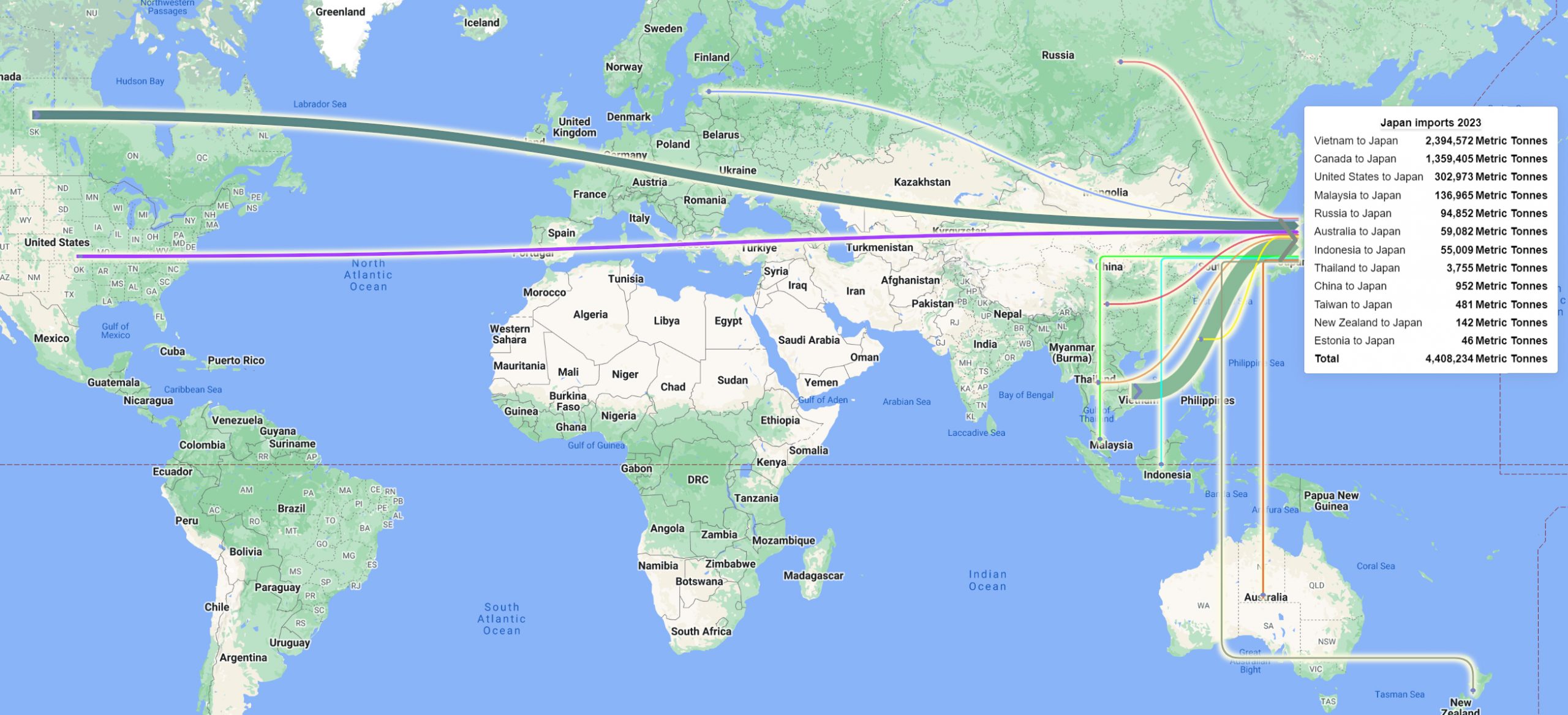
Examples of Services that FutureMetrics Provides
-
Operations
-
-
Optimization of quality, quantity, and cost at existing pellet factories
-
Turn arounds of underperforming pellet factories
-
Safety of operations and pellet storage
-
-
-
Developers
-
-
Pre-feasibility and feasibility studies
-
Owner’s representative during development phase
-
Strategic advice
-
-
-
Investors, lenders, and joint venture partnerships
-
-
New project due diligence (technical and financial)
-
Existing project technical audits, economic valuation, and ROI analysis
-
Market intelligence, strategic advice
-
-
Mitigating climate change is
the foundation of our mission.
A new record high of 428.59 ppm was set on April 26, 2024.
Use the mouse to zoom into recent data on the chart.
Historic and Current Atmospheric Greenhouse Gas Concentrations (and other data)
Data updated daily – The chart is interactive
The Global Wood Pellet Trade Flow Map has Complete 2023 Data.
Scroll down and click on the map.
-
Advice on all aspects of producing, transporting, and selling pellet fuel
-
Expert guidance and due diligence for potential investors, lenders, and project developers
-
Operations optimization for pellet plants
-
Strategic analysis and market research
-
Greenhouse gas mitigation strategies
(July 2, 2024)
Our most recent dashboard has been updated!
The dashboard now has two tabs that allow the user to calculate white pellet inventory and storage needs for a low capacity factor power station, AND allows the user to determine the optimal choice for pellet fuel for that station.
Direct link to the dashboard is HERE.
Go to the white papers page from the link below to get the recent white papers that describe the dashboard’s analysis.
___________
(May 30, 2024)
FutureMetrics Has Published a New Important Multi-Client Research Report
Advanced Biomass Solutions for Coal Substitution in Power Generation
This 90-page study contains a comprehensive technical and economic analysis of “black” pellet technologies.
Click on the “Research Studies for Purchase” tab at the top of this webpage to see more and to download the Table of Contents
DASHBOARDS
More than a dozen free to use dashboards that allow the user to experiment with scenarios relevant to the wood pellet sector.
Global Trade Flow Map shows where exporting nations’ pellets go and where importing nations’ pellets come from.
Data is from the calendar year 2023.
Click on the map image or HERE to open the Sankey map.
FutureMetrics’ Research Studies
If you are considering “black” pellets as either a producer or end user, you should read:
Advanced Biomass Solutions for Coal Substitution in Power Generation
Optimizing carbon-beneficial coal replacement for power generation when white pellets are not optimal
This 90-page study contains a comprehensive technical and economic analysis of “black” pellet technologies.
View the table of contents and abstract HERE.
To purchase, click HERE
(June 17, 2024) - What is the Pellet Fuel Storage Solution when a Power Station using Pellet Fuel only Operates During Part of the Year?
This short paper and the accompanying dashboard show the consequences of a mismatch between white pellet consumption at a power station with a low capacity factor and white pellet production by pellet factories with offtake agreements for that station. The dashboard illustrates the significant capital cost savings of avoiding the dry storage requirements of white pellets by using waterproof steam treated pellets.
(May 5, 2024) - Managing Increasing Atmospheric CO2 Concentrations and a Rapidly Changing Climate with Exponentially Increasing Demand for Electricity
This brief white paper discusses the rapid increase in current and forecast demand for electricity. The transition away from fossil fuel generated power will be challenged by demand growth. This paper offers a way to make baseload green power sustainably.
(Updated Charts May 2, 2024) - Have We Passed the Tipping Point for Climate Change? Charts Tell the Story!
This 4-page white paper shows how CO2 emissions are causing rapidly accelerating changes in ocean temperatures. The last chart suggests that we may have already passed the climate change tipping point!
(January 2, 2024) - Sometimes Black Pellets are the Optimal Choice for Power Stations Replacing Coal
This short white paper describes the decision-making model that every power boiler operator that is considering conversion from coal to pellet fuel should use. The decision-making model is built into an interactive dashboard that allows the user to experiment with a variety of inputs and see how, under some input combinations, black pellets, not white pellets, are the optimum choice for fuel.
(December 17, 2023) - FutureMetrics discusses COP28
On December 13, 2023, the United Nations Conference on Climate Change delivered the outcome of COP28. This comprehensive FutureMetrics white paper discusses the goals set out in the “first global stocktake”.
(October 2, 2023) - Analyzing the Impact of the French Announcement to Convert Two Coal Power Plants to Pellet Fuel
France has announced that its two remaining coal fueled power stations will run on 100% pellet fuel by 2027. This short analysis and NEW dashboard shows that this will result in significant growth in the industrial pellet fuel markets.
(September 17, 2023) - Heat Pumps - They are Great until they Aren't!
This white paper analyzes the operating costs of heat pumps. It shows that in colder climates, supplemental heat is always needed. And in many colder locations, they are NOT the lowest cost heating option.
(July 19, 2023) - This white paper and a new interactive dashboard provides a quantitative view of the US and Canadian forest products sector.
Where do you think lumber, furniture, flooring, paper, cardboard boxes, tissue, and toilet paper come from? A quantitative review of the North American forest products industry with a new interactive dashboard.
As the white paper and dashboard show, the export pellet sector only uses about 3.2% of the primary harvest directly from the forest. The rest goes to lumber, paper, etc.
(May 1, 2023) - Carbon dioxide levels in the atmosphere hit a new record high on April 28, 2023. Dr. Strauss discusses CO2 and climate change in a compelling call to action white paper.
Atmospheric concentrations of carbon dioxide (CO2) hit another new record high on April 28, 2023, of 425.01 parts per million (ppm). The implications are dire.
This white paper makes it clear that urgent meaningful action on carbon emissions policy is needed.
(March 24, 2023) - Carbon Negative! An analysis by Dr. Strauss that shows a pathway that the US can follow to join the offramp to a decarbonized future.
The International Panel on Climate Change (IPCC) recent report makes it clear that action is needed now.
This new analysis by FutureMetrics’ William Strauss describes a strategy that the US can follow that yields carbon negative results AND generates baseload power.
(March 14, 2023) - The story of one of the pioneers in the wood pellet sector, John Swaan
Twenty-five years ago, the first bulk shipment of industrial wood pellets traveled from British Columbia to the Helsingborg Energi power plant in Sweden, marking the birth of today’s multibillion dollar industrial wood pellet industry.
The person behind this accomplishment, John Swaan, tells some of the stories which led him to that first contract worth $1.67 million in 1998.
(February 20, 2023) - Can Pellet Factories Make Money in the Current Markets with their Legacy Offtake Agreements?
There has been much discussion recently about the offtake pricing relationships between pellet producers and pellet buyers.
Many years of near zero inflation resulted in some complacency in how offtake price adjustments were defined in the bilateral contracts between the pellet fuel producers and buyers. It became common to define an annual fixed adjustment to the sales price of the pellets; often in the range of 1.5% to 2.5%. With hindsight, it is obvious that this exposed producers to risk if the average cost of production increased faster than the price.
This brief white paper will set the foundation for the reader to use the dashboards that complements this analysis.
(October 31, 2022) - SUPPLY SHOCK! -Global Wood Pellet Fuel Markets in 2022
A supply shock occurs when a significant portion of a good or service is no longer available in the market and substitutes are scarce or non-existent.
This white paper describes how the loss of pellet fuel supply into western Europe and the UK as a result of sanctions on Russia has produced a supply shock that is having, and will continue to have, significant consequences.
(October 10, 2022) - How Wood Pellets are Improving Health and Ecology in Rwanda
This white paper shows how wood pellets and high efficiency gasifying pellet cookers will be beneficial to the people and ecology of Rwanda and many other countries in which people use smoky solid fuels for cooking.
FutureMetrics is honored and proud to be providing analysis and consulting services to BioMassters via the support of the Clean Cooking Alliance (an organization within the United Nations).
(August 29, 2022) - How the Inflation Reduction Act supports bioenergy carbon capture and sequestration in US power stations.
The Inflation Reduction Act has opened the door for what may be the most efficient and pragmatic approach to actively lowering atmospheric CO2 concentrations. Combining the use of fuel produced from the by-products of continuously growing managed forests with carbon capture results in the same outcome as direct air capture. This white paper and the new accompanying dashboard show how.
(June 25, 2022) - Do we really want to exclude all roundwood from being used to make pellet fuel?
There has been high-level discussion from some government policymakers in the EU about restricting the use of “roundwood” as feedstock for pellet fuel. While the spirit of the policymaking exercise is properly grounded as a tactic to disallow deforestation and encourage the most efficient use of a renewing resource, a blanket exclusion of “roundwood” is misguided. This white paper explains why. This white paper also discusses the dynamics of forest growth and carbon sequestration.
(April 21, 2022) - How High Inflation Might Impact the Industrial Wood Pellet Industry
This comprehensive 32-page white paper uses advanced simulation techniques to explore every part of the industrial wood pellet supply chain. The analysis shows how high inflation could impact the sector. The paper offers some thoughts on mitigating the negative impacts of high inflation.
(March 2, 2022) - Germany's Power Generation in 2022 and Beyond
This white paper discusses a biomass fuel strategy for the German power generation sector that has the potential to reduce dependence on imported natural gas, mitigate grid reliability risk, solidify baseload generation, and significantly reduce carbon dioxide (CO2) emissions. It is complimented by a new interactive dashboard.
(December 2, 2021) - The next wave of Japanese pellet fuel demand will be from the large utility power stations.
This white paper discusses how Japanese policy has set the foundation for the next wave of pellet fuel demand. It uses a real-world example based on recent announcements by J-Power and Enviva.
(October 14, 2021) - Will India become an importer of industrial wood pellets?
This brief white paper is motivated by a policy announcement in India on October 8 that mandates that 5% to 10% biomass pellets must be blended with coal by October 2022 in most of its coal fueled power stations.
This white paper quantifies the demand for biomass pellets based on the Indian coal fueled power generation fleet. It also offers an opinion on the potential for India to import wood pellets.
(September 9, 2021) - Enough Already with the Fallacy of Carbon Debt!
Even after years of explaining managed forest dynamics, the carbon debt misconception lives on.
To this day, and sometimes by academics with PhD’s after their names, the carbon debt fallacy is perpetuated. This white paper will explain why they get it wrong.
(July 26, 2021) - Why the industrial Pellet Fuel Sector should Work with the Wind and Solar Power Sectors
This white paper’s thesis is that the likelihood of evolving policy that supports continue growth in demand for pellet fuels might be significantly increased by focused efforts on cooperation between the pellet sector and the consortiums that advocate for wind power, solar power, and energy storage.
Cooperation in strategy and communications may yield a future in which government strategies and influential reporting will have a more complete view of how to get from today to a fully decarbonized power sector.
(July 5, 2021) - Pellets Version 2.0 will Lower the Barriers for Pellet Fuel as a Coal Substitute in Utility Power Stations
Version 1.0 of wood pellets, i.e., so-called “white” pellets, have been unchanged for decades. The promise of more advanced pellets has been around for at least two decades. So-called “black” pellets that do not lose their integrity when exposed to water, and have other characteristics that lower the barriers for adoption as a coal substitute, have not, to date, gained significant market share. This white paper discusses why and also shows how innovation may have opened the door, finally, to pellets version 2.0.
(May 3, 2021) - From Start to Finish - How to Subtract Carbon Dioxide from the Atmosphere and Produce Baseload Power
The idea of carbon capture and storage (CCS) used in conjunction with fossil fueled power generation is appealing. However, the best that CCS can achieve with fossil fuels is to approach CO2 neutrality. That is, they cycle carbon that has been sequestered over millions of years from out of the ground and then back into the ground. There is no net change in atmospheric CO2 as a result.
But we can do better. Carbon neutral is good, carbon negative is much better. This white paper envisions a future in which some of the existing coal fueled power stations are modified to use pellet fuel and capture and sequester the carbon dioxide produced from combustion. CO2 permanently removed from the atmosphere and renewable power are the result.
This paper is accompanied by a new dashboard. See below in the dashboard section. The dashboard is also directly linked from within the white paper.
(March 31, 2021) - What is the Lowest Cost Solution for Maximum Decarbonization of the Power Sector while Maintaining Grid Reliability?
If the goal of policy is to lower CO2 emissions in the power sector, the metric that should inform decision making should be based on the total investment and operating cost per avoided tonne of CO2.
This white paper will discuss this metric and will compare the analytics of two scenarios that provide on-demand dispatchable power: (1) Retire coal power plants and replace them with new natural gas combined cycle generating stations, and (2) modify existing pulverized coal power plants to use renewable industrial wood pellets as a substitute for coal.
(December 30, 2020) - Using Biomass Carbon Capture and Sequestration to achieve NEGATIVE carbon emissions
This short white paper and the accompanying dashboard show how combining the use of sustainably sourced wood pellets and carbon capture and sequestration in a power plant can achieve significant negative CO2 emissions. The paper shows why BCCS must be part of every decarbonization strategy.
(November 16, 2020) - A climate strategy for the Biden administration
The goal of attaining a carbon free electricity generation sector is necessary. But the path from today to that goal needs to be pragmatic. This white paper offers guidance for near and long-term solutions that the Biden administration can incorporate into their strategy.
Many more free papers are listed on the paper download page.
FutureMetrics’ Senior Team Members

Dr. Strauss has been named one of the most influential leaders in the biomass sector two years in a row in 2016 and 2017 by Argus Media. William Strauss is the recipient of the 2012 International Excellence in BioEnergy Award. In 2021 Dr. Strauss received the “Limitless Business Intelligence” award for his work in creating interactive online dashboards.

John Swaan, FutureMetrics’ operations expert, is the recipient of the 2014 International Founders Award. He is the founder of Pacific BioEnergy and producer of the first transatlantic shipment of wood pellets from North America to Europe (1998). John was honored with the “Lifetime Achievement Award” in April 2023 at the Argus Biomass conference in London.

Kayleigh Rayner Brown is a process safety specialist with expertise in hazard analysis, combustible dust, and inherently safer design in pellet manufacturing. Kayleigh is a Professional Engineer and holds a Bachelor of Science (Chemistry, Honors), Bachelor of Engineering (Chemical), and Master of Applied Science (Chemical Engineering, Process Safety).



